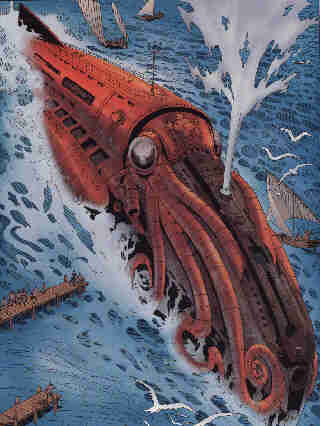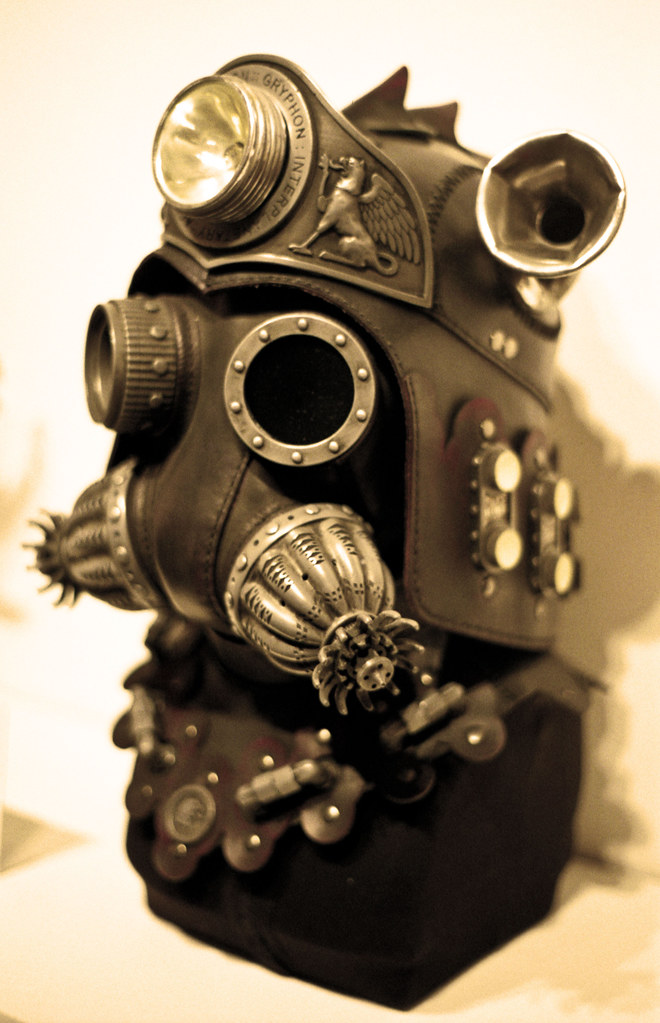
Science Fiction fans of Oxford are lucky to have the current Steampunk exhibition on their doorstep, at the Museum of the History of Science, Broad Street. This historic museum is perhaps the perfect place for the world premier exhibition dedicated to the art and science of this little known sub-genre and underground movement. Steampunk is a literary genre with a strong and growing fan base who embrace it with vigor, often dressing up in full Victorian-inventor attire and actively involving themselves in the scene, by designing art and objects or writing novels and comic books. Born in the eighties, around the same time as the Cyberpunk movement, Steampunk looks back to the Victorian period for stylistic inspiration, embracing the zeal for scientific experimentation and prophetic insight typical of the period dominated by such sci-fi giants as H.G. Wells and Jules Vern. But a certain punkish spirit also runs in its bloodlines. In much the same way that forgotten musical genres enjoyed resurgence in the wake of punk's cultural atomic flash, other areas of sub-culture and fandom went through renaissances of their own, the literary and comic world being no exception. Punk's levelling, grassroots call for individualism seemed to resonate within the hearts of other downtrodden subcultures. Typically looked down upon by mainstream culture, the Sci-fi and comic geeks were the outcasts of the literary world, their beloved genres sneered at by the serious minded literati.

But a hardcore underground movement had been growing for sometime. Many of the indie alternative book shops that sprung up around London in the early seventies such as Dark They Were And Golden-Eyed, as well as the nascent convention scene, seemed to be peopled by the same sort of outsider hippie types that fed into such idiosyncratic proto-punk shops as Granny Takes A Trip and Let It Rock. These young upstarts were beginning to learn the trade and would go on to make a mark on their respective industries in the aftermath of punk's year zero. It seems fair to suggest that the spirit of punk that hugely affected cultural output in the early eighties fed into these growing fan scenes, rejuvenating them with a questioning cynicism and fiercely independent outlook. Only in a post-punk world does the newly gritty, morally questioning and serious-minded comic revolution of Alan Moore, for example, really make sense. The do-it-yourself spirit of punk percolated through into such sectors of society, thus inspiring new lineages to break out. 2000AD for example, a British comic publisher born in the eighties, and starting point for many of today's anarchic British Invasion comic creators, is characterized by its gritty aesthetic nods to punk and sneering, tongue-in-cheek disregard for convention. Indeed, many early examples of the steam- and cyberpunk look can be found in its pages, including the bizarre imperial war machines found in Nemesis the Warlock, and the grimy dystopian mood of Judge Dredd. The Steampunk aesthetic is a strange mixture of Victorian design flourishes in dark wood, brass and tough leather, with the sturdy functionality of bare cogs and gears, reflecting the considerable industrial advancement of the Victorian era. This is all carried off with a youthful narcissistic eye for detail, particularly in the beautifully designed costumes of the scene's participants. Waist coats and bodices customised with straps and cogs, are typical, creating the mad inventor meets gothic dandy look. There's an invigorating enthusiasm reflected in Steampunk, which considers the mechanical age and the potential it harbours with a wide-eyed wonderment somewhat removed from Cyberpunk's techno-cynicism. Steampunk strikes a far more positive chord, by creating its own alternative history which indulges itself in historical speculation and dares to ask 'what if' of the steam era. It paints a whimsical alternative present that has grown out of the industrial age and bypasses our digital age completely, revelling in a retro-futurism and mechanical fetishism that is fantastical and awe-inspiring in its reach.
For more info check out the exhibition and this blog dedicated to it, which has many other related links.


You can't call the steam style of the 80's "steampunk"...the term "steampunk" comes from the comics titled steampunk...there is no steampunk before steampunk...around year 2000.
ReplyDeleteniko...i respectfully disagree. you can retrogressively define something. it wasn't called steam punk at the time, sure. but you can draw a line of influence from the aesthetic of the 80s comics, and indeed hg wells et al. these things are considered 'steampunk' with hindsight, though they were never called that at the time obviously.
ReplyDelete